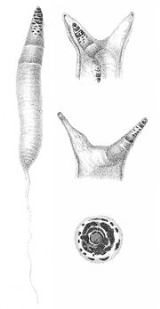
Leucochloridium paradoxum
Encyclopedia
Leucochloridium paradoxum, common name green-banded broodsac, is a parasitic flatworm
(or "helminth
") that uses gastropods
as an intermediate host
.
The resulting behavior of the flatworm is a case of aggressive mimicry
, where the parasite vaguely resembles the food of the host. This gains the parasite entry into the host's body; this is unlike most other cases of aggressive mimicry, in which only a part of the host resembles the target's prey and the mimic itself then eats the duped animal.
This life cycle is similar to other species of genus Leucochloridium
.
Other locations include: Norway and others.
hosts:
Flatworm
The flatworms, known in scientific literature as Platyhelminthes or Plathelminthes are a phylum of relatively simple bilaterian, unsegmented, soft-bodied invertebrate animals...
(or "helminth
Parasitic worm
Parasitic worms or helminths are a division of eukaryoticparasites that, unlike external parasites such as lice and fleas, live inside their host. They are worm-like organisms that live and feed off living hosts, receiving nourishment and protection while disrupting their hosts' nutrient...
") that uses gastropods
Gastropoda
The Gastropoda or gastropods, more commonly known as snails and slugs, are a large taxonomic class within the phylum Mollusca. The class Gastropoda includes snails and slugs of all kinds and all sizes from microscopic to quite large...
as an intermediate host
Intermediate host
A secondary host or intermediate host is a host that harbors the parasite only for a short transition period, during which some developmental stage is completed. For trypanosomes, the cause of sleeping sickness, humans are the primary host, while the tsetse fly is the secondary host...
.
Life cycle
The worm in its larval, miracidia stage, travels into the digestive system of a snail to develop into the next stage, sporocyst. The sporocyst grows into long tubes to form swollen "broodsacs" filled with tens to hundreds of cercariae. These broodsacs invade the snail's tentacles (preferring the left, when available), causing a brilliant transformation of the tentacles into a swollen, pulsating, colorful display that mimics the appearance of a caterpillar or grub. The broodsacs seem to pulsate in response to light intensity, and in total darkness do not pulse at all. The infection of the tentacles of the eyes seems to inhibit the perception of light intensity. Whereas uninfected snails seek dark areas to prevent predation, infected snails have a deficit in light detection, and are more likely to become exposed to predators, such as birds. Birds are the definitive hosts where the cercariae develop into adult distomes in the digestive system of the bird. These adult forms sexually reproduce and lay eggs that are released from the host via the bird's excretory system. These droppings are then consumed by snails to complete the life cycle of this parasitic worm.The resulting behavior of the flatworm is a case of aggressive mimicry
Aggressive mimicry
Aggressive mimicry is a form of mimicry where predators, parasites or parasitoids share similar signals with a harmless model, allowing them to avoid being correctly identified by their prey or host...
, where the parasite vaguely resembles the food of the host. This gains the parasite entry into the host's body; this is unlike most other cases of aggressive mimicry, in which only a part of the host resembles the target's prey and the mimic itself then eats the duped animal.
This life cycle is similar to other species of genus Leucochloridium
Leucochloridium
Leucochloridium is genus of parasitic worms.-Species:Species in the genus Leucochloridium include:* Leucochloridium caryocatactis * Leucochloridium fuscostriatum Robinson, 1948...
.
Distribution
Leucochloridium paradoxum was originally reported from Germany.Other locations include: Norway and others.
Hosts
intermediate hosts:- Succinea putrisSuccinea putrisSuccinea putris is a species of small, air-breathing land snail, a terrestrial pulmonate gastropod mollusc in the family Succineidae, the amber snails.-Distribution:Distribution: European-Siberian region.* Czech Republic - least concern * Germany...
hosts:
- birds
- Zebra FinchZebra FinchThe Zebra Finch, Taeniopygia guttata, is the most common and familiar estrildid finch of Central Australia and ranges over most of the continent, avoiding only the cool moist south and the tropical far north. It also can be found natively in Indonesia and East Timor...
(Taeniopygia guttata) – experimental
External links
- Leucochloridium paradoxum, Animal Diversity WebAnimal Diversity WebAnimal Diversity Web is an online database that collects the natural history, classification, species characteristics, conservation biology, and distribution information of thousands of species of animals...
- Distome (Leucochloridium paradoxum), The Living World of Molluscs
- Infecting a Snail: Life Cycle of the Grossest Parasite, Wired Magazine

